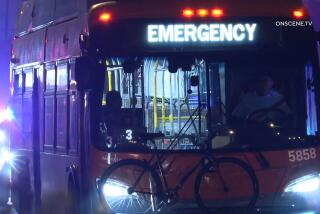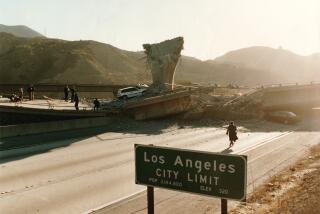BAY AREA QUAKE : BART Gives Thousands Smooth but Crowded Lift to Work
- Share via
SAN FRANCISCO — As the jam-packed Bay Area Rapid Transit train descended early Monday into its tunnel under San Francisco Bay, the eyes of its passengers opened wide. A few exchanged nervous smiles, a silent acknowledgement of fear.
But Ethel Oden spoke optimistically about the transportation system that linked her East Bay home to work in San Francisco.
“I’m not afraid of being trapped in the tunnel during a quake,” she said. “It was the freeways that fell and the buildings that collapsed. The safest place to be is in the subway.”
On Monday, anyway, it was also one of the most popular places to be, as the 17-year-old transit system affirmed the faith of Ethel Oden and more than 100,000 others. On the day that traffic experts looked to the Bay Area with dread, BART bore the brunt of residents’ scrambling efforts to avoid gridlock.
Undaunted by slashing rain and a chill wind, a record number of commuters forced out of their cars by the earthquake’s destruction deluged train stations and squeezed into rail cars. Hundreds lined up outside closed station gates as early as 4 a.m. to assure themselves of both a parking place--which proved the toughest victory of the day--and a seat on the rush-hour trains. Hours later, they crowded 20 deep at ticket stations to start the ride home.
It was chaotic. BART and thousands of transit neophytes met for the first time Monday, and the union was not always pretty. First-time riders showed up with $20 bills, and when those wouldn’t work in ticket machines, they had to beg money from others. Elsewhere, BART workers hawked tickets like carnival hucksters. In North Berkeley, they signed up Teresa Kennedy, the second alto in the East Bay Faith Center choir, to do to their bidding. “Tickets! BART tickets! $5! $10! $20! $30!” she sang.
It was crowded. Each BART car holds 72 seats, and virtually all were filled Monday during the morning and evening rush hours, even though BART had added cars to each of its trains. Another 60 to 70 people jammed into each car as well, standing uncomfortably for the duration of their trip, a common plight in transit systems of other cities but rare for BART. According to BART officials, nearly 273,000 people had ridden the trains by 8:30 p.m. A typical day would have seen 220,000 passengers, officials said.
“This morning, this afternoon--I felt like a head of cattle,” mourned commuter Jim Hampton.
But BART officials were beaming, sure that the system’s performance Monday would win them converts. Not that many commuters have much choice, with four major freeways in the Bay Area knocked out by the earthquake’s wrath and unlikely to be repaired soon.
“This is BART’s shining hour,” said Michael Healy, a transit system spokesman.
The trip in from Concord, the northernmost BART station on the East Bay, was typical.
At 5:45 a.m., the sprawling parking lot surrounding the Concord BART station was filled to capacity. In the pre-dawn darkness, headlights turned toward the exits and drivers began parking along residential streets as far as half a mile away.
“I think I got the last place in the lot,” said a triumphant and smiling Alida Boonstra, a BART regular. “It was one tiny space hidden between two trucks.”
Subway novices abounded. Women in high heels slid about as they tried to maneuver across the station. Others fumbled with ticket machines and awkwardly bumped through turnstiles.
The veterans, however, were prepared--they arrived wearing rain boots and carrying monthly passes.
“This is unbelievable. I’ve never seen it like this,” Boonstra said.
As commuters collapsed their soaking umbrellas and rushed toward escalators, the station manager blurted over the intercom:
“Do not run! Do not run!”
When the doors of the 6 a.m. Concord train slid closed, it was standing room only in all 10 cars.
And the crowds built as the workday drew closer. By the third stop of 10 before San Francisco, not one additional person could slip onto the train. The windows fogged, blurring the masses of commuters waiting at other stations.
One woman tried to sneak into a train car at one station, only to hear a stern warning from the intercom: “Please clear the door!” She backed away.
Inside the steamy train, several passengers began to rethink their options.
“Maybe I should start looking for a job on this side of the bay,” Boonstra said. “I’m not sure how long I can keep up with this.”
But despite the crowded conditions and the hectic tenor of the day, several infrequent BART riders said they were impressed with the speed of subway travel.
And some first-time riders were thinking of abandoning the Bay Bridge and the car commute altogether.
“This is fabulous,” said Ed Grochowsky, 64, who travels to San Francisco several times a week for medical treatment. “I had always thought it was easier to drive, but parking in San Francisco is harder than parking at the station.”
While the rain drew criticism from just about everyone, there were few complaints about the BART system itself, apart from the crush of the crowds.
Systemwide, only one temporary train breakdown was reported in the morning. A second delay, in the evening, was blamed on an impatient commuter who jammed a door trying to board.
“Everyone was well-behaved,” said BART spokesman Healy. “There were no altercations or reports of rude pushing.”
More to Read
Sign up for Essential California
The most important California stories and recommendations in your inbox every morning.
You may occasionally receive promotional content from the Los Angeles Times.










